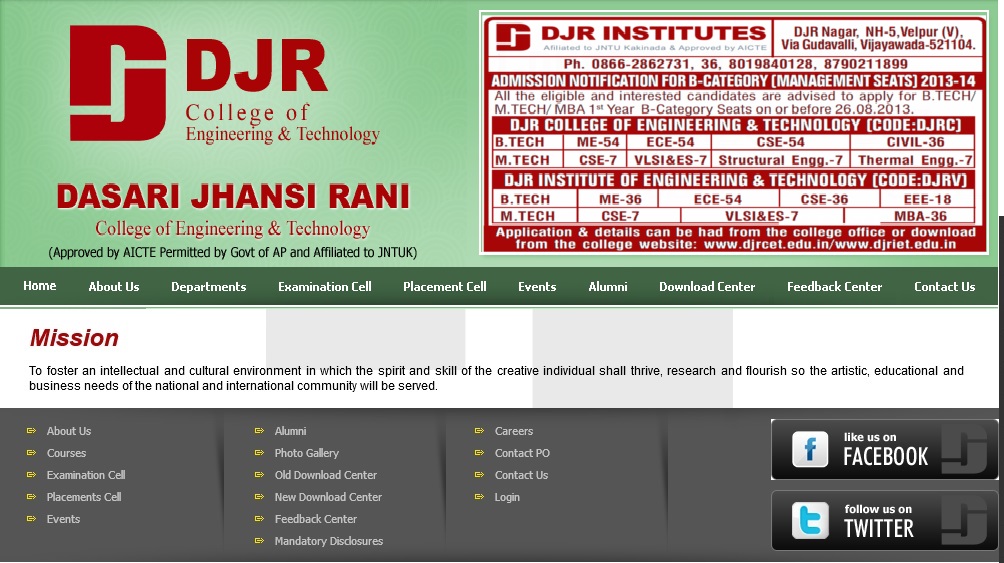RR310503 Data Communications B.Tech Question Paper : djriet.edu.in
Name of the College : Dasari Jhansi Rani Institute Of Engineering And Technology
University : JNTUK
Department : Computer Science And Engineering
Subject Code/Name : RR310503 – Data Communications
Year : 2008
Degree : B.Tech
Year/Sem : III/I
Website : djriet.edu.in
Document Type : Model Question Paper
Data Communications : https://www.pdfquestion.in/uploads/djriet.edu.in/2951-RR310503-DATA-COMMUNICATIONS.pdf
DJRIET Data Communications Model Question Paper
III B.Tech I Semester Supplimentary Examinations, November 2008 :
DATA COMMUNICATIONS :
( Common to Computer Science & Engineering, Information Technology and Computer Science & Systems Engineering)
Time: 3 hours
Max Marks: 80
Related : Dasari Jhansi Rani Institute Of Engineering & Technology Data Base Management Systems B.Tech Question Paper : www.pdfquestion.in/2946.html
Set – I
Answer any FIVE Questions :
All Questions carry equal marks :
1. (a) What is topology? Explain topologies in Data Communications?
(b) What are the various types of transmission modes and explain. [8+8]
2. (a) Explain what is serial and parallel Data Transmission. When do you use serial parallel transmission.
(b) What is configurations? Explain what are the types of configurations in Data Communications? [8+8]
3. (a) What is a transparent switch? A transactional switch.
(b) What are the purposes of the nr and ns sequences on SDLC? What is delimiting sequence? [6+10]
4. What are the LAN transmission data formats in EEE 802×LANs. Explain. [16]
5. (a) What is DQDB? Explain different DQDB network architectures.
(b) Discuss about DQDB protocol architecture. [6+10]
6. (a) What is ISDN? Describe the services provided by it.
(b) Discuss the evolution of ISDN. [10+6]
7. (a) Discuss about VP switch and routing with it used by ATM.
(b) Elaborate on the types of connections used by ATM. [8+8]
8. How many VT2s, VT3s and VT6s can be carried in an STS-1 frame? [16]

Set – II
1. (a) What is ‘Interface’in Data Communications?
(b) Mention any one of the Interface standard, and draw its architecture. [5+11]
2. (a) What is Data Communications? Explain briefly Data communication circuit.
(b) Mention some standard organizations for Data Communications? [10+6]
3. Explain about IBM’s Bisync Protocol? [16]
4. (a) Draw the block diagram of a typical local area network component configuration and explain. What are the typical characteristics of LAN.
(b) Write range of data services, where LAN’s are used extensively. [10+6]
5. (a) Discuss about principles of queued arbitrated access protocol.
(b) Explain the algorithm used to control the transmission of segments on bus A of a dual bus DQDB subnetwork. [6+10]
6. (a) What is ISDN? Describe the services provided by it.
(b) Discuss the evolution of ISDN. [10+6]
7. (a) Discuss the advantages and disadvantages of frame relay over X.25 networks.
(b) Discuss about frame relay operation. [5+11]
8. Draw a SONET network using all of the following devices. Label all lines, sections and paths.
(a) Three STS multiplexers( Two as input and One as output)
(b) Four add/drop multiplexers.
(c) Five regenerators. [16]
Set – III
III B.Tech I Semester Supplimentary Examinations, November 2008
Data Communications
Common to Computer Science & Engineering, Information Technology and Computer Science & Systems Engineering
Time: 3 hours
Max Marks: 80
Answer any FIVE Questions
All Questions carry equal marks
1. (a) What is the difference between Analog signal and Digital signal, with example.
(b) Explain about Analog Data, Analog Signals, is this encoding technique exist or not? [10+6]
2. (a) What is Serial Interfaces? What are the various standard Interfaces?
(b) Explain about RS-232 Interface? [4+12]
3. (a) Define the three operating modes used with data communications circuits?
(b) What is the function of the clearing character? What is a unique address? A group addresses? A broadcast address? [8+8]
4. Explain CSMA/CD operation? [16]
5. (a) Differentiate between PAP and CHAP.
(b) Give an overview of different switching methods. [8+8]
6. (a) Differentiate between NT1 and NT2.
(b) What is reference point. Explain different reference points. [8+8]
7. (a) Compare the format of an HDLC protocol frame with a frame relay protocol frame. Which fields are missing in the frame relay protocol frame? Which fields are added in the frame relay protocol frame?
(b) Is there a need for a sliding window in frame relay protocol. [8+8]
8. Discuss the SONET configuration as a physical carrier for ATM. [16]
Set – IV
III B.Tech I Semester Supplimentary Examinations, November 2008
Data Communications
Common to Computer Science & Engineering, Information Technology and Computer Science & Systems Engineering
Time: 3 hours
Max Marks: 80
Answer any FIVE Questions
All Questions carry equal marks
1. (a) Explain about Data link layer, Network layer and Transport layer on OSI model.
(b) What is protocol? [10+6]
2. What is synchronization? Explain about character synchronization? What are the types of data formats. [16]
3. (a) What is the Difference between selection and polling? And explain.
(b) Explain about Control field on SDLC protocol? [8+8]
4. List and describe the access control methods? [16]
5. (a) What is DQDB? Explain different DQDB network architectures.
(b) Discuss about DQDB protocol architecture. [6+10]
6. (a) What is ISDN? Describe the services provided by it.
(b) Discuss the evolution of ISDN. [10+6]
7. (a) Differentiate between packet and cell networks.
(b) Discuss about asynchronous TDM used by ATM. [8+8]
8. (a) Elaborate on the concerns addressed by the designers of SONET.
(b) List different SONET/SDH rates. [8+8]